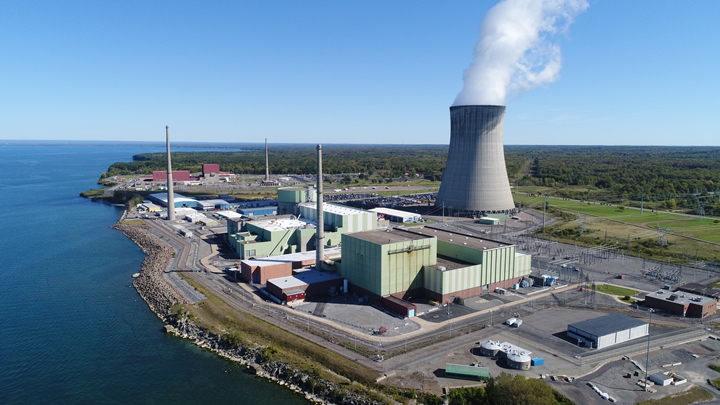Can Nuclear Infrastructure Help Meet the Energy Demand of AI
Nuclear power presents a reliable solution to meet this increased demand, by offering stable baseload power to ensure a consistent supply of electricity that can help stabilize the electrical grid and that AI infrastructure can depend on.
Global nuclear power capacity to reach 494GW by 2035, driven by advancements in SMRs and clean energy shift, says GlobalData
While nuclear power accounted for around 9% of global electricity generation, countries with aging reactors have pursued lifetime extensions, while others have aggressively expanded their nuclear fleets, especially in Asia.
Recent Advancements in Small Modular Reactor (SMR) technology
Despite the positive characteristics of SMRs, the high costs and dangers of radioactive material deprioritize the technology compared to traditional and reliable energy sources like fossil fuels.
Up to 20 IDS cameras support Munich-based Start up, Marvel Fusion GmbH in their research
The deep-tech company has developed a novel laser-based approach to Nuclear fusion that can produce CO2-free, clean, safe electricity
Recent Advancements in the Field of Nuclear Power
Recent advancements and developmental efforts have been made in nuclear energy, including advanced designs for nuclear plants/reactors, waste management, nuclear accidents, and more.
Constellation Starts Production at Nation's First One Megawatt Demonstration Scale Nuclear-Powered Clean Hydrogen Facility
State-of-the-art facility will demonstrate the value of producing hydrogen with carbon-free nuclear energy to help address the climate crisis
Nuclear Fusion : Could This Be the Next Thing?
Although weaning off fossil fuels in favor of nuclear fusion will take massive amounts of time and money, this incredible feat for man will be a giant leap for all of mankind.
Advancements in Nuclear Energy Technology (Small Modular Reactors)
SMRs are used to decrease capital costs and help economies with series production and short construction times. They are designed with module factory fabrication and generally use less than 300 MWe.
Recent Advancements in Nuclear Technology : an Overview
Many researchers claimed that smaller modular reactors (SMRs) are the way to address the existing issue with reactor designs. SMRs are designed to generate up to 300 MW of electric power, and the parts of the reactors can be easily broken down and transported to plants.
What is ITER?
The original name is The International Thermonuclear Experimental Reactor (ITER). It is an international nuclear fusion research and engineering megaproject. This will be the world's largest magnetic confinement plasma physics experiment.
Community Monitoring at Ground Zero Nuclear Test Sites
The program currently encompasses twenty-four monitoring stations placed in publicly-accessible areas of communities surrounding the Nevada National Security Site (NNSS). To keep these systems running full-time, the DRI turned to Morningstar solar charge controllers.
Is Nuclear Energy Still Viable?
Our aging nuclear plants need to be replaced but the new ones fail to compete on price with natural gas and renewable sources such as wind and solar energy.
Broad energy coalition condemns action to subsidize failing coal, nuclear plants
Proposed action to bail out nuclear, coal plants is misguided, would hurt consumers
How Was Renewable Production Able to Surpass Nuclear Power?
In March, renewables provided 21.6 percent of the nations net electricity generation compared to nuclears 20.34 percent. In April, that lead jumped to 22.98 percent compared to 19.19 percent from nuclear.
Is solar power in nuclear disaster exclusion zones advisable?
ARNOLD GUNDERSEN for Bulletin of the Atomic Scientists: My own experience near solar arrays in Fukushima Prefecture indicates that the problems of building and maintaining solar installations in a contaminated nuclear wasteland are over-simplified, and worse, totally ignored. One of the greatest burdens of maintaining operating atomic reactors is the cost of working in a Radiologically Controlled Area. (The Lawrence Berkeley National Laboratory defines a Radiologically Controlled Area as: “Any area to which access is managed to protect individuals from exposure to radiation or radioactive materials. Individuals who enter Controlled Areas without entering Radiological Areas are not expected to receive a total effective dose equivalent of more than 0.1 rem (0.001 Sievert) in a year.”) Each nuclear power plant operates with specific instructions and constraints, with Radiation Work Permits tailored for each specific maintenance activity. Because special clothing, special respiratory equipment, and special radiation monitoring equipment are routinely required to perform even minimum maintenance activities inside a nuclear power plant, every activity takes longer, costs more, and requires more people inside each reactor than necessary in any other industrial setting.
Consequently, the question becomes: Does building solar panels on land contaminated with nuclear waste resemble work in a normal industrial setting, or is it more similar to work inside a radiologically contaminated atomic reactor—at significantly higher cost? Full Article:
Records 1 to 15 of 16
Featured Product
OMCO Origin® Factory-Direct Trackers
A One-In-Portrait (1P) solution that support a wide range of solar projects (utility scale, distributed generation (DG), & C&I markets). Manufactured and factory preassembled in the USA at one of OMCO Solar's 5 US plants (AZ, IN, AL, OH), OMCO makes all structural components with domestic steel and now can offer a 100% domestic tracker. OMCO Origin® Factory-Direct Trackers include universal module mounts with options for all commercially available modules, labor-saving bearings with 6 adjustable ways to compensate for posts and terrain issues, and foundation solutions for every terrain including OMCO C Piles.








.jpg)





